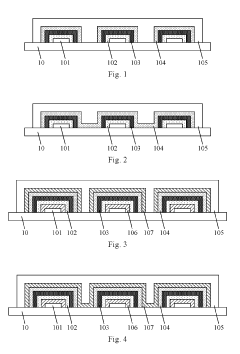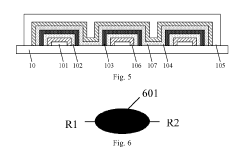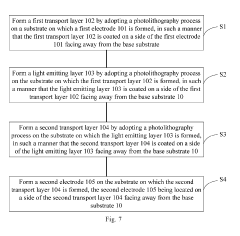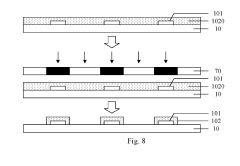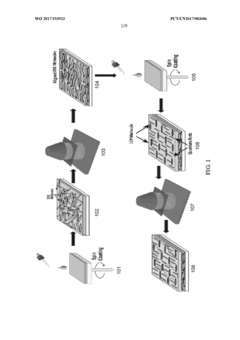Future Trends in QLED Displays for Enhanced Image Quality
QLED Display Evolution
QLED display technology has undergone significant evolution since its inception, driven by the continuous pursuit of enhanced image quality and energy efficiency. The journey began with the development of quantum dots, nano-sized semiconductor particles that emit light of specific wavelengths when excited. These quantum dots were initially used as a color conversion layer in LCD displays, marking the first generation of QLED technology.
As research progressed, the second generation of QLED displays emerged, featuring improved quantum dot materials and more sophisticated manufacturing processes. This iteration brought about better color accuracy, wider color gamut, and increased brightness, setting new standards for display performance. The integration of quantum dots directly into the LED backlight unit further enhanced energy efficiency and color purity.
The third generation of QLED displays saw the introduction of quantum dot color filters, replacing traditional color filters in LCD panels. This innovation allowed for even more precise color reproduction and improved light transmission, resulting in brighter and more vibrant images. Additionally, advancements in quantum dot synthesis and encapsulation techniques led to increased stability and longevity of QLED displays.
Recent developments have focused on self-emissive QLED technology, often referred to as QD-OLED or electroluminescent quantum dot displays. This approach eliminates the need for a separate backlight, potentially offering perfect black levels, infinite contrast ratios, and wider viewing angles. While still in the early stages of commercialization, self-emissive QLED displays represent a significant leap forward in display technology.
The evolution of QLED displays has also been characterized by improvements in manufacturing processes, including the development of more efficient quantum dot deposition methods and the integration of quantum dots into flexible and transparent substrates. These advancements have expanded the potential applications of QLED technology beyond traditional flat-panel displays to include curved, foldable, and even transparent displays.
Looking ahead, the future of QLED display evolution is likely to focus on further enhancing image quality through increased color volume, higher peak brightness, and improved HDR performance. Research into new quantum dot materials, such as perovskite quantum dots, holds promise for even better color purity and efficiency. Additionally, the development of micro-LED backlight technology in conjunction with quantum dots may lead to ultra-high-resolution displays with exceptional contrast and energy efficiency.
Market Demand Analysis
The market demand for QLED displays with enhanced image quality continues to grow rapidly, driven by consumer expectations for superior visual experiences across various applications. In the consumer electronics sector, high-end televisions and monitors are witnessing a surge in demand for QLED technology, as it offers vibrant colors, deep blacks, and excellent contrast ratios. This trend is particularly pronounced in the premium segment, where consumers are willing to pay a premium for cutting-edge display technology.
The gaming industry is another significant driver of QLED display demand. Gamers seek displays with high refresh rates, low input lag, and exceptional color accuracy, all of which are strengths of QLED technology. As gaming becomes increasingly competitive and visually demanding, the market for high-performance QLED gaming monitors is expected to expand substantially.
In the professional sector, content creators, graphic designers, and video editors require displays with precise color reproduction and high dynamic range. QLED displays are gaining traction in this market segment due to their ability to accurately represent a wide color gamut, making them ideal for color-critical work.
The automotive industry is emerging as a promising market for QLED displays. As vehicles become more technologically advanced, there is a growing demand for high-quality in-car entertainment systems and digital dashboards. QLED technology's brightness and color performance make it well-suited for automotive applications, where displays must be visible in varying lighting conditions.
The commercial display market, including digital signage and large-format displays for public spaces, is also showing increased interest in QLED technology. The ability to produce bright, vivid images that maintain clarity even in well-lit environments makes QLED displays attractive for retail, hospitality, and corporate settings.
Looking ahead, the market demand for QLED displays is expected to be further fueled by advancements in resolution, with 8K displays becoming more prevalent. Additionally, the integration of QLED technology with other emerging display technologies, such as micro-LED, is likely to create new market opportunities and drive innovation in image quality enhancement.
As sustainability becomes a more significant concern for consumers and businesses alike, there is a growing demand for energy-efficient display technologies. QLED displays, with their potential for improved power efficiency compared to traditional LED-LCD displays, are well-positioned to meet this market need, particularly as manufacturers continue to refine and optimize the technology.
QLED Tech Challenges
QLED (Quantum Dot Light Emitting Diode) technology has made significant strides in recent years, offering enhanced color reproduction and brightness compared to traditional LED displays. However, as the demand for higher image quality continues to grow, QLED displays face several technical challenges that need to be addressed to maintain their competitive edge in the market.
One of the primary challenges is improving the color gamut and accuracy. While QLED displays already offer a wide color gamut, there is still room for improvement in achieving more precise and consistent color reproduction across different viewing angles and brightness levels. This requires advancements in quantum dot materials and color management algorithms to ensure that colors remain vibrant and true-to-life under various viewing conditions.
Another significant challenge is enhancing the contrast ratio and black levels. QLED displays typically use a backlight system, which can lead to light leakage and reduced contrast in dark scenes. Developing more effective local dimming technologies and improving the light-blocking capabilities of quantum dot films are crucial steps in addressing this issue. Additionally, research into new quantum dot materials that can achieve deeper blacks without compromising brightness is ongoing.
Power efficiency remains a concern for QLED displays, particularly as screen sizes and resolutions continue to increase. Improving the energy efficiency of quantum dots and optimizing the backlight system are essential for reducing power consumption while maintaining high image quality. This challenge is closely tied to the development of more efficient blue LEDs, which serve as the primary light source in many QLED displays.
Durability and longevity of QLED displays pose another technical hurdle. Quantum dots can degrade over time, especially when exposed to heat and moisture. Enhancing the stability of quantum dot materials and developing more robust encapsulation techniques are critical for ensuring the long-term performance and reliability of QLED displays. This is particularly important for applications in harsh environments or devices with extended usage periods.
Manufacturing scalability and cost-effectiveness present ongoing challenges for QLED technology. As the demand for larger and higher-resolution displays grows, developing more efficient and cost-effective production methods for quantum dot materials and display components becomes crucial. This includes improving the yield and uniformity of quantum dot deposition processes and optimizing the overall display manufacturing workflow.
Lastly, addressing potential environmental and health concerns associated with certain quantum dot materials, particularly those containing heavy metals, is an important challenge. Research into alternative, eco-friendly quantum dot compositions that maintain high performance while minimizing environmental impact is an active area of investigation in the QLED field.
Current QLED Solutions
01 Quantum dot enhancement for color reproduction
QLED displays utilize quantum dot technology to enhance color reproduction and image quality. Quantum dots are semiconductor nanocrystals that emit light of specific wavelengths when excited, allowing for more precise and vibrant color representation. This technology enables QLED displays to achieve a wider color gamut and improved color accuracy compared to traditional LED displays.- Quantum dot enhancement for color and brightness: QLED displays utilize quantum dot technology to enhance color reproduction and brightness. This technology allows for a wider color gamut and improved luminance efficiency, resulting in more vibrant and lifelike images. The quantum dots are typically applied as a layer in the display structure, converting blue light from LEDs into pure red and green light, which contributes to the overall image quality improvement.
- Advanced color processing and management: QLED displays incorporate sophisticated color processing algorithms and management systems to optimize image quality. These systems may include color mapping, gamut expansion, and dynamic range adjustment techniques. By precisely controlling color reproduction and enhancing contrast, these advanced processing methods contribute to improved overall picture quality and viewer experience.
- High dynamic range (HDR) implementation: QLED displays often feature HDR technology, which allows for a wider range of brightness levels and improved contrast. This results in more detailed images with better highlights and shadows. HDR implementation in QLED displays may involve local dimming techniques, enhanced backlight control, and specialized image processing algorithms to maximize the display's dynamic range capabilities.
- Pixel structure and arrangement optimization: The image quality of QLED displays is influenced by the design and arrangement of pixels. Advanced pixel structures, such as those with optimized subpixel layouts or micro-LED integration, can enhance resolution, reduce color fringing, and improve overall image sharpness. Some QLED displays may also incorporate pixel compensation techniques to address uniformity issues and improve display performance.
- Motion handling and refresh rate improvements: QLED displays often incorporate advanced motion handling technologies to reduce blur and improve the clarity of moving images. This may include high refresh rates, motion interpolation algorithms, and backlight scanning techniques. These features contribute to smoother motion rendering and reduced artifacts in fast-moving scenes, enhancing the overall perceived image quality, particularly for content such as sports or action movies.
02 Local dimming and contrast enhancement
QLED displays employ local dimming techniques to improve contrast ratios and enhance image quality. This involves selectively dimming or brightening specific areas of the screen based on the content being displayed. By controlling the backlight in different zones, QLED displays can achieve deeper blacks and brighter highlights, resulting in improved overall contrast and image depth.Expand Specific Solutions03 Image processing algorithms for picture quality
Advanced image processing algorithms are implemented in QLED displays to enhance picture quality. These algorithms can include techniques such as noise reduction, sharpness enhancement, color management, and motion interpolation. By applying sophisticated processing to the input signal, QLED displays can optimize image quality and deliver a more refined and visually appealing picture.Expand Specific Solutions04 High dynamic range (HDR) implementation
QLED displays often incorporate High Dynamic Range (HDR) technology to expand the range of brightness and color that can be displayed. This allows for more realistic and lifelike images with improved contrast, deeper blacks, and brighter highlights. HDR implementation in QLED displays can significantly enhance the overall visual experience and image quality, particularly for content mastered in HDR formats.Expand Specific Solutions05 Pixel structure and arrangement optimization
The pixel structure and arrangement in QLED displays are optimized to improve image quality. This can include techniques such as sub-pixel rendering, pixel density optimization, and innovative pixel layouts. By refining the pixel structure and arrangement, QLED displays can achieve higher resolution, improved sharpness, and reduced visual artifacts, contributing to overall better image quality.Expand Specific Solutions
Key QLED Manufacturers
The QLED display market is in a growth phase, driven by increasing demand for high-quality image displays. Major players like Samsung Display, BOE Technology, and TCL China Star Optoelectronics are competing to advance QLED technology for enhanced image quality. The market size is expanding rapidly, with projections indicating significant growth in the coming years. Technological maturity varies among companies, with Samsung leading in commercialization, while others like LG Display and Corning are making strides in research and development. Universities such as The Hong Kong University of Science & Technology and MIT are contributing to fundamental research, pushing the boundaries of QLED technology for future applications.
BOE Technology Group Co., Ltd.
TCL China Star Optoelectronics Technology Co., Ltd.
QLED Innovations
- An OLED array substrate with a light emitting layer that includes photocurable or photodegradable functional groups, eliminating the need for a pixel defining layer by using photolithography to form high-resolution pixel structures, where the light emitting layer wraps the first transport layer, which covers the electrode, thereby improving resolution and reducing signal crosstalk and non-uniformity.
- Utilization of photoaligned quantum rod enhancement films (QREFs) to improve optical efficiency and color gamut of LCDs.
- Integration of quantum rods that emit polarized light, potentially reducing the need for traditional polarizers and improving overall display efficiency.
- Development of a scalable production method for QREFs involving photoalignment and polymerization steps.
QLED vs. OLED Comparison
QLED (Quantum Dot Light Emitting Diode) and OLED (Organic Light Emitting Diode) are two leading display technologies competing for dominance in the high-end display market. Both offer superior image quality compared to traditional LCD displays, but they achieve this through different mechanisms.
QLED displays utilize quantum dots, which are semiconductor nanocrystals that emit light when excited by an electric current. These quantum dots are typically made of materials like cadmium selenide or indium phosphide. QLED technology builds upon existing LCD infrastructure, using quantum dots to enhance color and brightness.
OLED displays, on the other hand, use organic compounds that emit light when an electric current is applied. Each pixel in an OLED display is self-emissive, meaning it can produce its own light and can be turned off completely for true blacks.
In terms of image quality, OLED displays generally offer better contrast ratios and deeper blacks due to their ability to turn off individual pixels completely. This results in more vibrant and realistic images, especially in dark scenes. QLED displays, while not achieving the same level of black, can produce brighter overall images and more saturated colors.
Color accuracy is another important factor in image quality. QLED displays typically offer a wider color gamut, meaning they can reproduce a larger range of colors. This is particularly noticeable in bright, vivid scenes. OLED displays, while still offering excellent color reproduction, may not match the peak color volume of QLED.
Longevity and burn-in resistance are areas where QLED displays have an advantage. OLED displays can suffer from burn-in, where static images can leave a permanent mark on the screen. QLEDs are less susceptible to this issue, making them potentially more suitable for applications with static elements, such as news tickers or gaming HUDs.
Energy efficiency is an area where OLED displays excel. Since they can turn off individual pixels, they consume less power when displaying darker content. QLED displays, which require a backlight, tend to consume more power regardless of the content being displayed.
In terms of viewing angles, OLED displays maintain better color and contrast when viewed from off-center angles. QLED displays have improved in this area but may still show some color shift or loss of contrast at extreme angles.
As both technologies continue to evolve, the gap in performance is narrowing. Future developments in quantum dot technology, such as electroluminescent quantum dots, may bring QLED closer to OLED in terms of contrast and power efficiency. Meanwhile, advancements in OLED materials and manufacturing processes are addressing issues of brightness and longevity.
Sustainability in QLED
Sustainability has become a crucial aspect of QLED display technology as the industry moves towards more environmentally friendly practices. QLED manufacturers are increasingly focusing on reducing the environmental impact of their products throughout the entire lifecycle, from production to disposal.
One of the key areas of improvement is the reduction of energy consumption during the manufacturing process. Advanced production techniques and more efficient equipment are being implemented to minimize energy usage and reduce carbon emissions. Additionally, manufacturers are exploring ways to optimize the supply chain, reducing transportation-related emissions and improving overall sustainability.
The use of eco-friendly materials in QLED displays is another significant trend. Researchers are developing new quantum dot materials that are free from heavy metals, such as cadmium, which can be harmful to the environment. These alternative materials not only reduce the ecological footprint but also improve the safety and recyclability of QLED displays.
Efforts are also being made to enhance the energy efficiency of QLED displays during operation. Advanced power management systems and more efficient backlight technologies are being integrated to reduce power consumption without compromising image quality. This not only benefits the environment but also appeals to consumers looking for energy-efficient devices.
Longevity and durability are becoming increasingly important factors in QLED sustainability. Manufacturers are focusing on improving the lifespan of QLED displays, reducing the need for frequent replacements and minimizing electronic waste. This includes developing more robust components and implementing better heat management systems to prevent premature degradation of the quantum dots.
The end-of-life phase of QLED displays is also receiving attention in terms of sustainability. Manufacturers are designing products with easier disassembly and recyclability in mind. This includes using modular designs and materials that can be more easily separated and recycled. Some companies are also implementing take-back programs to ensure proper disposal and recycling of old QLED displays.
As the demand for sustainable technologies grows, QLED manufacturers are also exploring ways to incorporate renewable energy sources into their production facilities. Solar panels and wind turbines are being installed at manufacturing sites to reduce reliance on fossil fuels and decrease the overall carbon footprint of QLED production.
In conclusion, sustainability in QLED technology is a multifaceted approach that encompasses the entire product lifecycle. From eco-friendly materials and energy-efficient production to improved durability and recyclability, the QLED industry is making significant strides towards a more sustainable future. These efforts not only benefit the environment but also contribute to the long-term viability and competitiveness of QLED technology in the display market.
